
June To Date Miramichi Salmon Report
Fishing Friends –
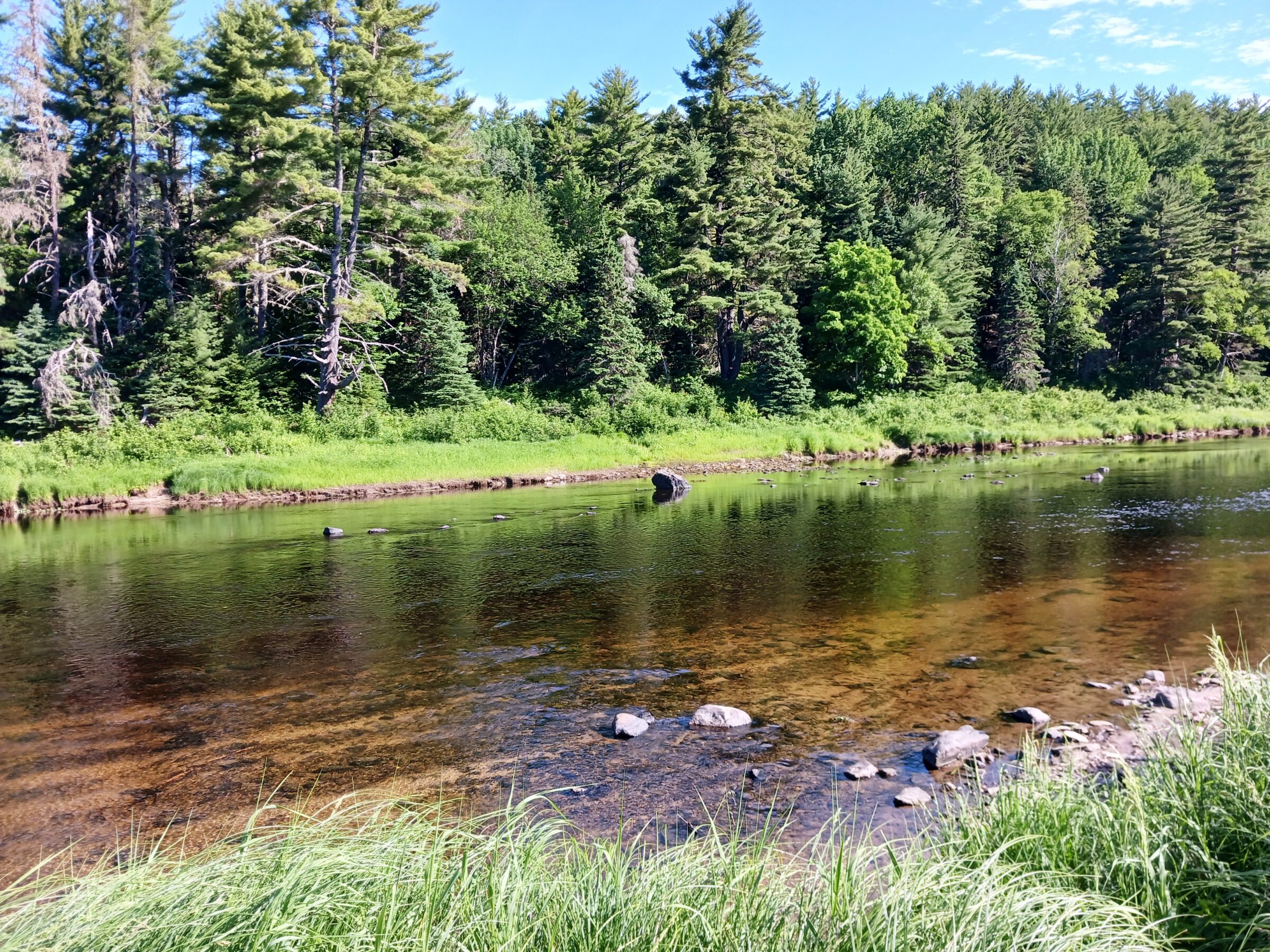
Darrell Warren was in mowing the Brophy Pool on Thursday and said this was some of the lowest water he’s ever seen there. Luckily it is too early for many fish to head up the Cains. This will all be changing for the better over the next few days.
I made a quick trip home to Maine on Tuesday the 16th when I knew that the heat wave was inevitable. On both Wed and Thur the water
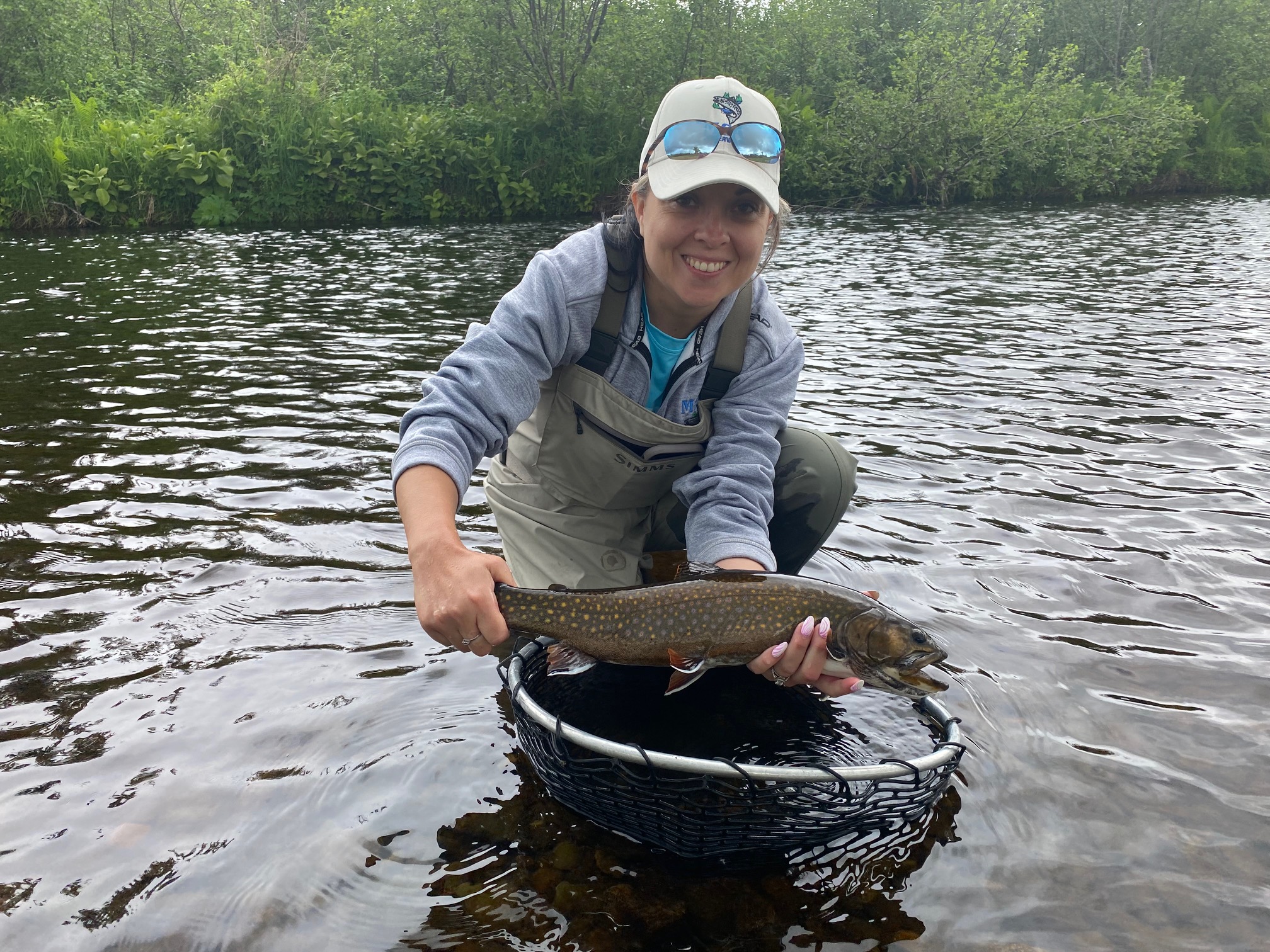
How quickly we went from spring to summer heat. Hilary Palmer releases a beautiful upper SWM brookie not much over a week ago.
temperature reached 28C/82F in Blackville. On Friday it backed off to 26C/76F and this morning, Saturday 6/22 it is down to 23C/73F at first light. DFO first closed their list of cold water refuge pools and now has restricted angling to 6-11 AM. Perhaps the greatest mitigating factor is that there are currently very few fish in the system, and what few that are here have located to cold water refuges, all of which are still relatively flush with early season water. Black Brook’s Eddie Colford says that they have both salmon and shad holding up in the cool waters of the brook. He didn’t sound like it was very crowded, though, and there have been no dead fish. That’s a very good thing. We should be back to normal temperatures by Sunday evening.
We have several days of relatively cool and rainy weather to look forward to this upcoming week. I’ll be heading back to Blackville on Sunday, and I’m hoping that we’ll see a decent run of salmon develop with a raise of cooler water.
I was in camp last week from the evening of the 10th through the morning of the 16th. During that time, we would see one or two salmon jump on their way upstream most sessions, but we never got a hook in one. Black Brook caught a fish or two and so did Country Haven, but all in all it was very quiet. I noted that the DFO fish trap at Millerton had 2 through May 31 and 8 through June 15. That is the same as last year and 2021. In 2022 there were 12. As the roughest possible rule of thumb, you need to multiply that by 20 to make a best guess of the actual number coming up the river. The traps only catch a percentage and that varies with a number of factors including water height.
I remember Willy Bacso e-mailing me that it was the last day of June and he had yet to catch a salmon. He fished all day and finally got a grilse. This was in the very early 2000s, and the runs in those years were much greater than today’s. The message is that runs during June can be very iffy – especially the first half of June – but what a reward if you luck out.
Still another piece of information was a very recent trip a friend of mine made to Rocky Brook. This country is about 20 miles upriver of Boiestown, and the river there is fed by a series of large brooks coming down from hill country with considerably more elevation than the ground surrounding the lower river. It is relatively cool up there throughout the summer, and this is where many of the early run fish are headed. The group did catch a salmon and two grilse, but the report was that there were definitely less fish there than in other recent years by this date.
 Beyond salmon – if there is such a scenario – I caught three shad during my stay at Campbell’s. That is roughly as many as I’ve caught over the last 20 years combined. This is also the lowest water June I can remember since 2004, and perhaps that helps. The adult shad are too big for even the largest Miramichi stripers, but I’m sure that along with alewives/gaspereau, that the bass take a big toll on them when the young of both species go to the sea in the fall.
Beyond salmon – if there is such a scenario – I caught three shad during my stay at Campbell’s. That is roughly as many as I’ve caught over the last 20 years combined. This is also the lowest water June I can remember since 2004, and perhaps that helps. The adult shad are too big for even the largest Miramichi stripers, but I’m sure that along with alewives/gaspereau, that the bass take a big toll on them when the young of both species go to the sea in the fall.
It is also likely that the salmon haven’t been as inclined to enter the river early this year due to much lower-than-average water levels. Hopefully they will soon try to make up for lost time.
Participants in the Plamu or salmon conference hosted in April by First Nations, and participated in by quite a number of salmon conservation groups, outfitters representatives etc. are still waiting for the report on the meeting. Apparently, the report has to be viewed by the major participants and their approval sought that the conclusions jive with what was intended. What I have heard from virtually everyone who attended, though, is that we must reduce the bass numbers to 100,000 spawners for the bass and salmon to coexist in some state of healthy abundance in the Miramichi. Every other consideration is really very secondary. If you haven’t read John Ritter’s report from my last blog, please go back and read it. Ritter is the retired DFO head of diadromous fish – including both salmon and bass – for the Maritimes, and he knows what he is talking about.
It also seems to me that DFO is not coming around as fast as everyone would like – and frankly as is needed – on this issue. Here’s an example. One of the consistent asks by the MSA and the ASF is that all striped bass taken in the summer from the Miramichi waters upstream of the head of tide may be retained – regardless of size or number. This would amount to nothing when compared to the overall striper population, since only a tiny percentage of the population spends the summer in the freshwater portions of the river. It would, though, save the lives of thousands of parr over the course of the season.
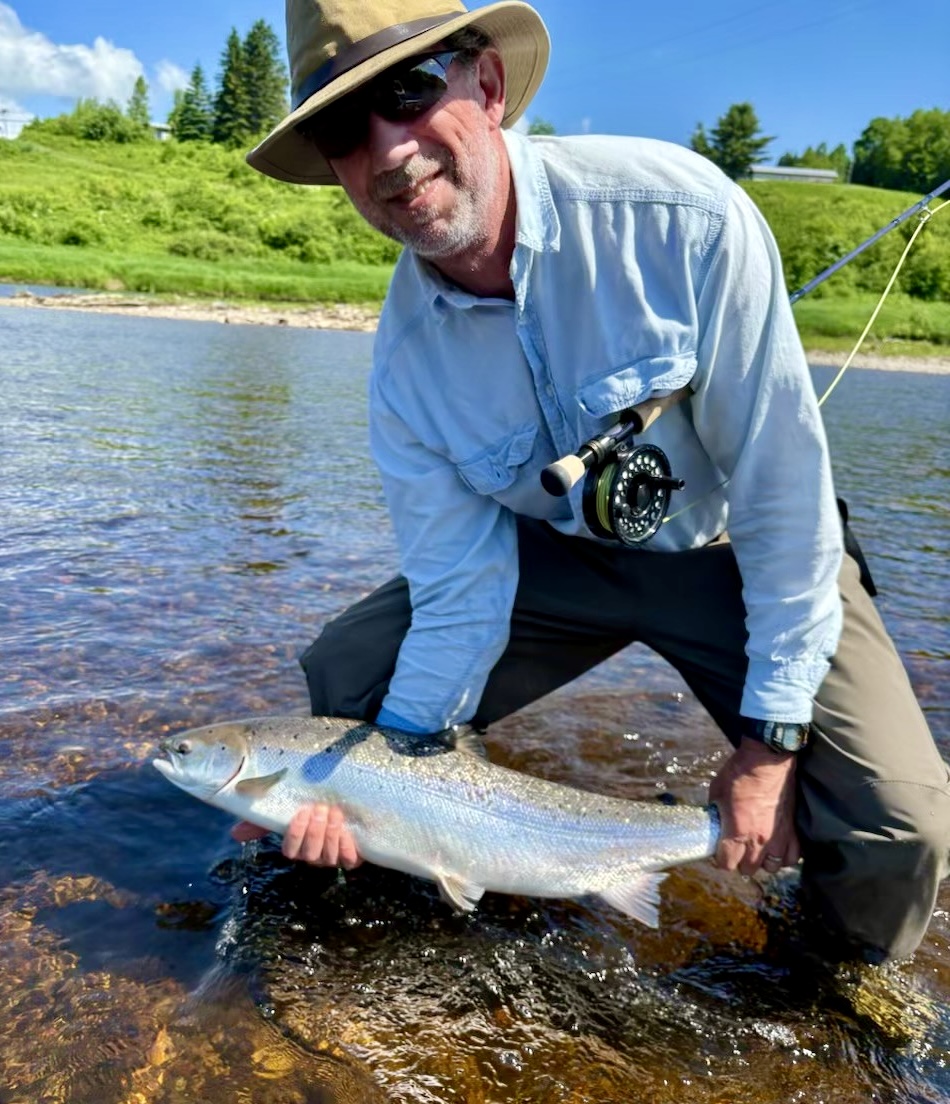
It’s silver salmon like this one caught in 2024 by Harold Barry that bring angler’s to Miramichi outfitters like Country Haven, Wilson’s, The Ledges, Sutters and Upper Oxbow.
I have been hearing since last fall that this was going to happen, and it almost did. What we did get was called a “scientific program” that allows the guides at 12 private lodges and outfitters on the river to keep the bass. This is a relatively small sampling of fishers, and it prohibits all the local anglers from being involved. Beyond this considerable shortcoming is the burden of a report that is supposed to be compiled by the guides and sent in on a weekly basis. It is mandatory to return it within a month, and 12 separate questions must be answered for each fish caught. The likely result of all this is that no one will have the time to bother with it. What was needed was just a simple regulation that removed all size and bag limits on striped bass caught above the head of tide in the Miramichi from May 15 to October 15. Oh yes, that is another complaint of mine, the beginning of this program wasn’t until June 15 after most of the bass feeding on outgoing salmon smolts have moved back down to the estuary.
To me it just reaffirms the message coming out of DFO, and that is they are not going to willingly reduce bass numbers no matter what the consequences for the salmon and other anadromous fish of the Miramichi. We must be successful in changing this attitude. An example of the increasing level of frustration can be seen in this very recent letter to the Minister of DFO by John Bagnall of the New Brunswick Salmon Council. Bagnall calls a spade a spade here when he says that the NW Miramichi’s salmon population is on its last legs due to DFO not following the recommendation of the House of Commons to balance the populations of the bass and salmon resources in the Miramichi.
Without a doubt, the simplest, quickest and most easily monitored way to catch the striped bass needed to balance the bass and salmon populations is by allowing these trap nets to retain and sell the bass that they now have to remove and release from their nets. Often, we’re told, there are so many bass that it is simply too large a job to separate them from the gaspereau, and the nets are just opened, and everything is allowed to escape.
Last week I had several members of the New Brunswick’s Atlantic salmon scientific community over to Campbell’s for a day of fishing. The overwhelming sentiments of this group were that DFO needs to wake up and smell the roses when it comes to Miramichi salmon. It is time now to reduce the bass population through commercial fishing activity, and simultaneously to allow SAS – stocking of adult salmon – into the Miramichi to quickly rebuild outgoing smolt numbers.
With this combined approach we can hopefully see significant progress towards recovering the river’s salmon population within a relatively few years. If bass numbers are left where they are, the iconic Atlantic salmon resource of the Miramichi will soon be lost to everyone. As one of my Canadian hockey playing friends said, it is time for those who care about Miramichi salmon to foil the knuckles.
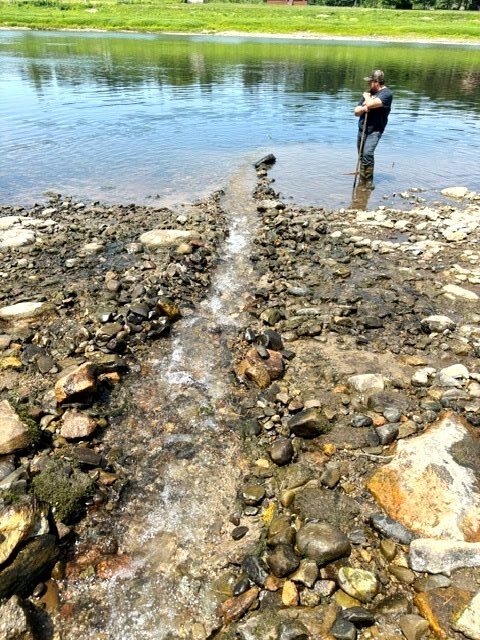
Country Haven’s Tyler Coughlan and guide Colby Donovan channelized this Miramichi stream to keep its cooling waters from heating up as they trickled through the stoney delta. Dr. Antoin Sullivan says this would be a worthwhile annual treatment for all of the many small streams along the lower Miramichi’s course.




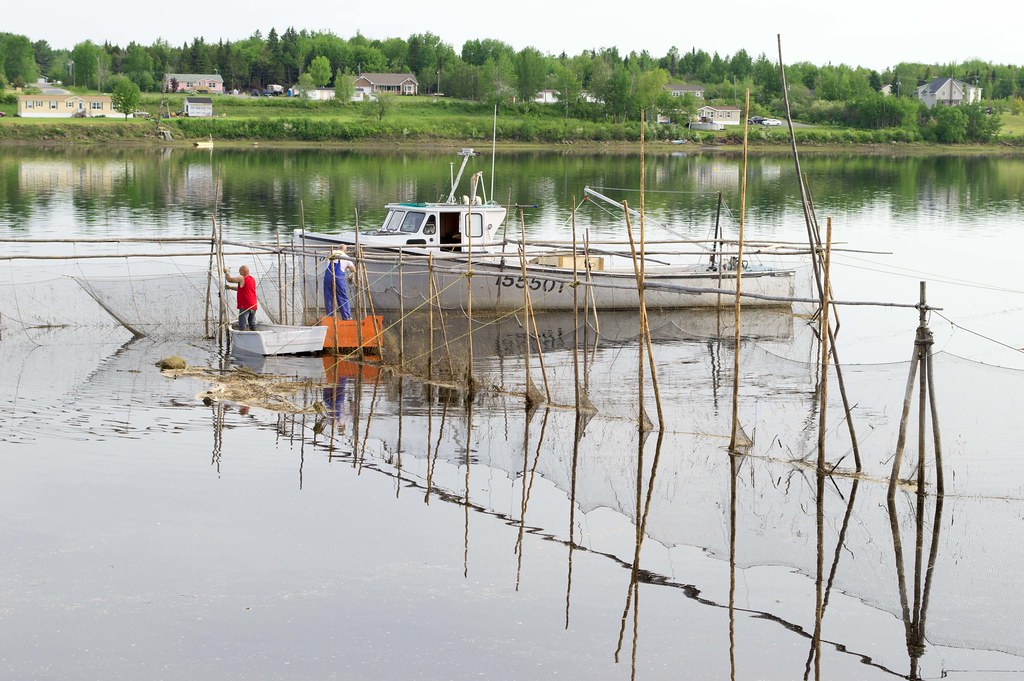
You are bang on, Brad, when you say the retention of all striped bass caught above the head of tides should be legal for any angler. There is only one reason for the stripers to push upriver and we all know that is food. The ‘license’ for certain outfitters/guides to retain these fish is a very small step. Every angler should have this right. It is not time for studies and surveys, it is time for action. A great increase in all stocking programs must occur. Reduction of striper numbers must be taken seriously. It boggles my mind that the Minister of Fisheries, Diane LeBouthier, put her name on an August 2023 document entitled, ““Engaging on a strategy to restore and rebuild Atlantic salmon”, and that no meaningful change has occurred. The response I received in November from Senior Assistant Deputy Minister, Niall O’dea, indicated the ‘strategy’ would be available for review in early 2024 lol… It appears there is only one strategy, ‘do very little, and talk out of both sides of their mouths.’ There currently is no commitment from the Minister’s office for any restoring or rebuilding of Atlantic Salmon and time is running out.
Yes, clearly our hope that the new minister from the East Coast would be helpful on salmon isn’t working out. A different strategy is called for.
I think that the title “Senior Assistant Deputy “ says it all about the morass of bureaucracy at DFO
I need to install a LIKE button…
Great letter to DFO from Mr. Bagnall. Short and pointedly clear. Not holding my breath but sure hope DFO acts.
Thanks Brad for all you do.
Tom